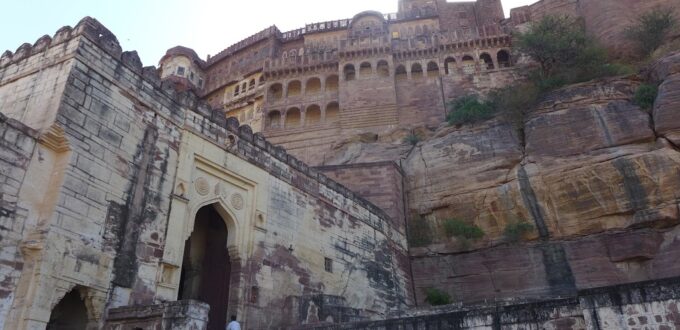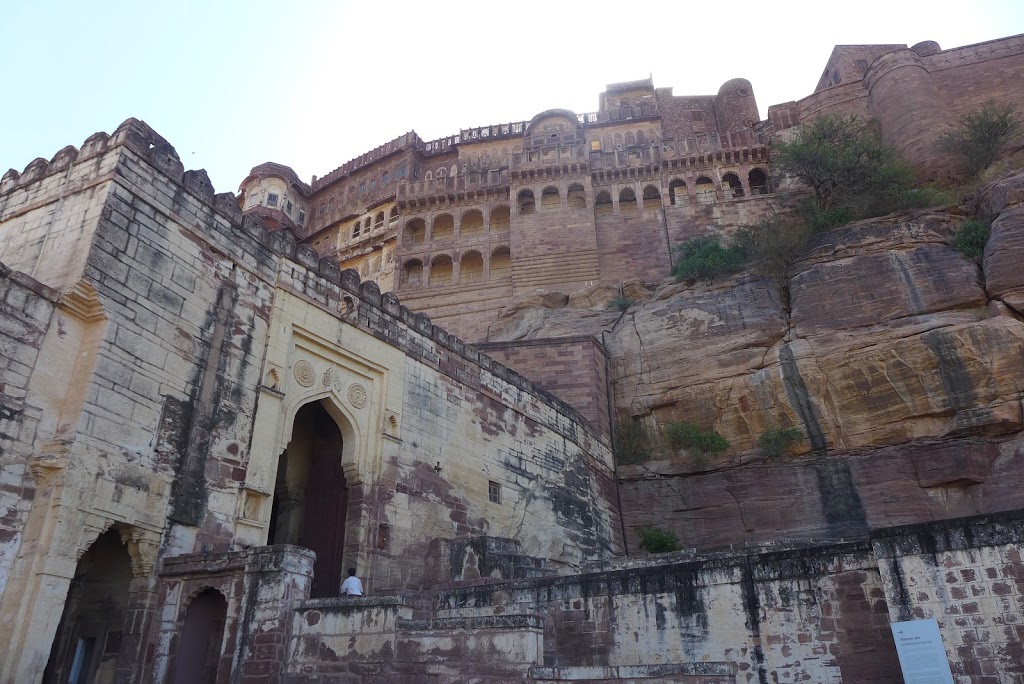
 |
| The driver’s sidekick |
The journey to Jodhpur took the whole day, and began rather amusingly. First, explanation. Every bus here has not only a driver, but also a sort of sidekick who sells tickets and stands in the door all the time shouting and waving at the pedestrians and generally trying to get more people on the bus. Second explanation: if all seats are taken on the bus, people sit in the space next to the driver. If even those spaces are taken, you can still fit in fifteen Indians.
 |
| Train station |
But apparently there were limits. The sidekick guy on the bus from Pushkar seemed to have a particular difficulty with understanding the concept ‘full’, and was outraged when twice in a row a whole Indian family actually refused to get on the bus after they’ve been pointed to a 10cm sitting space between impossibly squished passengers. He was talking to no one in particular for a good few minutes then, pointing at the little space with a mix of disbelief and anger.
The rest of the journey was rather uneventful. I arrived in the evening, found a reasonably cheap hostel and started getting used to sleeping with earplugs again – Pushkar has been merciful in this respect, but Jodhpur is a pretty busy town, so it’s a necessity.
 |
| Market clocktower and the fort |
On the next day I went towards the enormous Mehrangarh Fort which hovers over the city growing straight out of a rocky mountain which dwarves the one Edinburgh Castle stands on. The walk through the narrow lanes of the Blue City was really nice – it’s quite picturesque here, and the fact that Rajasthan seems to be a bit cleaner than Madja Pradesh helps too (mind you, that doesn’t mean it’s clean here, merely instead of disgustingly filthy it’s merely horribly messy). I was somewhat puzzled when at the top I found out that most people preferred a comfy bus to the interesting climb, but well, tourists.
The fort itself was quite an experience. It’s really impressive, the sheer size of the thing dazzles – you could fit five Edinburgh Castles in it and there would still be space. But that’s not the point, it’s the palaces inside that really do it. Arranged around four sizable courtyards are walls of latticework, perforated stone walls with intricate designs and decorations stretching four floors up. The museum inside shows the history of the fort and its Maharajahs, the way some of the rooms were arranged in the 19th century, and displays a selection of miniatures, weapons and objects of all sorts. The descriptions of the exhibits were of the mathematical kind: a pink velvet dress with red floral pattern and gold embroidery was described as ‘dress, pink velvet, red floral pattern, gold embroidery’.
In one room some guy was playing raga music on his santoor, a string instrument similar to cymbals. He was sceptical about letting me have a try on it, but the fact that I’m a musician convinced him. He must have liked it in the end because he gave me his CD free of charge.
 |
| Love the perforated stone |
The museum had a decent audioguide, but most of the time I could hardly hear it over the noise – the several buses worth of Western tourists were respectful, it was the Indians who just wouldn’t shut up. The Indians keep talking and shouting all the time. I`m not sure if it’s the way they speak, or does Hindi require a nasal high pitched voice and sounding like one was constantly angry. Even normal talking in Hindi sounds like it was arguing. Although this might not be the language, but the way people use it – whenever I go to Poland I get the impression that everyone speaks with some sort of barely hidden resentment in their voice or is at the verge of starting an argument. Yet I know that Polish can be spoken gently. Maybe Hindi is like that, just twenty times more.
At the exit from the fort I bought a very expensive scarf to support a charity which works to empower Rajasthani women by providing education and teaching them crafts, thus helping them become independent. This might be the right point to stop and mention the issue of equal rights in India. They don’t exist. Back on Elephante Island a female guide was telling me about an incarnation of Shiva in which he is both male and female (represented with one breast and androgynous face), which symbolises the equality of sexes. This, the guide said bitterly, has nothing to do with actual life here.
 |
| The blueness of the blue city |
The miniatures I saw in the fort representing the Maharajah and his court are an extreme example, here women are obviously display objects or toys. But life doesn’t seem far from that. It’s a horribly patriarchal society in which women have nothing to say in anything that matters, can’t do what they want and are constantly guarded. I see many women here, but none of them dare say anything to me. Once I approached a couple asking for directions and they actually escaped. While men stare at me, women look, but avoid eye contact. They work, but rarely in places where they would have to talk to other people – shops are more often run by 12yo boys than women. Men and women don’t seem to mingle, on the streets they form separate groups, unless they are obviously family. In the couple cases in which men walking with women said hi, they did not introduce the women. And now a big one: a few days ago I read a news story about a woman who was raped and after receiving no support from the local police went to see some senior staff. What she heard from some senior policeman was: ‘raped? Impossible! You’re 35, who would rape such an old woman?’ Yes. I don’t think I need to comment. It’s that bad.
 |
| View from the ‘military’ hill |
After the fort I started walking towards a nearby hill which seemed to have a temple on it and promised a good view. A autorickshaw driver stopped me, said that I can’t get on that hill because it’s military structures and ‘no possibel’, but he can give me a lift to the nearby Jaswant Thada memorial. I said I’ll walk, and decided to check out the hill anyway. Naturally, the bastard was lying, the way was open and there was nothing military about the place. At the top there was a sort of temple and a single priest who slept in it, woke up to invite me in, and fell back asleep. I sat there for quite a while and wrote down more of the thoughts I mentioned when I left Sumatra. Still not ready.
Following this, a brief visit to Jaswant Thada, a memorial to Maharaja Jaswant Singh II, and I started moving towards town through the narrow lanes of the old town, between the blue buildings towards the Sardar Market. On the way I found a better and cheaper hostel, so I moved. Food, a little more exploring and catching internet in a nearby restaurant completed the day.
 |
| I love how those windows look from the inside |
Before I go to sleep, an overdue reflection on communication. If you ask an Indian for something, nine times out of ten you will receive one of two replies: ‘no problem’ or ‘no possibel’. If something is ‘no possibel’, it can either mean that it’s really impossible, or that the person is too lazy to get it, or it is in the person’s interest that you don’t get it, or in case of haggling, that you can get the price down by at least another 30%. If something is ‘no problem’, it means that either the person will get it for you but usually about three hours after the promised time, or that the person doesn’t know how to get it yet, but knows a guy who knows a guy who might get it, or in some cases didn’t even understand the question but really wants your money. In case of haggling it means that you’re overpaying at least double. I know I sound a bit like this was a Diskworld novel, but here it’s real.
 |
| The Market |
Today was a waiting day. Jodhpur is the city of spices, and I decided to make some new shopping. The hostel staff are a bunch of really nice guys (first time since Indonesia), and one of them took me to a place where they buy spices for their restaurant. We had to wait almost an hour for the owner to actually show up and open, but the place was really good, a decent selection of spices and tea, so I thought, what will I bring from India for myself and friends if not that, and went quite mad on the shopping. About a hundred pounds later I had a pack I’m taking to Britain, and two packed parcels, one going to Poland, one to Australia. There will be spices enough until the end of time!
The shopkeeper offered help with the packing, and it was great, though I had to wait for the box for about an hour. After that, cloth packing. Indian regulations, parcels have to be packed in cloth and sealed with one seal every four fingers of seam. This took another hour and a few hundred. Finally, post office. Queue. Half an hour later, tons of documents to fill, more waiting, and done! Now I’m only hoping that the parcels will actually arrive…
This took the better part of the day, but in the afternoon I managed to make a trip to the Umaid Bhavan palace. Built as a residence on the Jodhpur Maharajahs, the building is still their home, but also hosts an exclusive hotel and a museum. Just as the fort, the palace is huge, supposedly the largest in India. The museum and the part available to the public are rather small and essentially devoted to convincing people that the Maharajah is awesome. But then, I guess the whole palace is, that’s what palaces are for. On the whole the visit was rather disappointing – I had to travel quite far and expensively to not really see the building and check out a collection of photos, some pretty decent art deco household items, and not see any of the lavish interiors the palace is famous for.
A little more strolling around town, shopping for a travel bag, and it’s time to use some internet!








I love how you present details in a concise and concise manner that is simple to follow.